Vol 4 No. 48 TROPIC LIGHTNING NEWS December 1, 1969
Index
Rangers Topple 10 Down by Riverside
By SGT TONY CAMELIO
CU CHI - While conducting a night ambush southwest of Fire Support
Base Jackson along the Oriental River, a combined force of six ARVN soldiers
from the 25th ARVN Division’s Reconnaissance Company and three Rangers from
Tropic Lightning’s Company F, 75th Infantry surprised and killed 10 enemy
soldiers.
“We knew that the enemy had been using the cover of darkness to
cross the river, but didn’t know where,” said patrol leader Sergeant Robert
Lawrence of Johnston City, Ill. “While we moved along the river we
noticed a sampan covered with trees and a path running to it, we decided we
couldn’t have picked a better place to set up our ambush.”
The patrol set up a linear ambush along the path placing an
American on each flank and one in the middle.
“As the night grew longer it started to rain and fog started to
roll in from the river. Soon we weren’t able to see more than 19 feet to
our front and had to depend almost entirely on our hearing,” said Sergeant
Joseph Snively of Lake Alfred, Fla., the assistant patrol leader. “Soon
we heard what sounded like 10 to 15 people sloshing through the rice paddies
coming directly towards us.”
Specialist 4 Reynold Myers of Bear Lake, Mich., the M-60 machine
gunner and left flank man said, “The footsteps became louder and louder until
I could see one coming straight towards me about 10 feet to my front. It
was very tempting to open up on him as it must have been for the ARVNs, but the
ambush had to be initiated by the patrol leader. He couldn’t have been
more than five feet from me when all hell broke loose. I killed the lead
man and started to spray the whole area with everything I had.”
When illumination was called in and all firing had stopped, Snively
and two of the ARVNs made a sweep of the area, finding 10 enemy bodies, one
AK-47 rifle, two Chicom pistols and three rucksacks filled with medical
supplies.
Ex-Foe, Cav Find The Deadly
CU CHI - A hoi chanh (rallier) who told interpreters he was the
last surviving member of his Viet Cong unit led elements of Alpha Troop, 3d
Squadron, 4th Cavalry to a large weapons cache 12 miles northwest of Cu Chi.
The hoi chanh said the weapons had been buried in the same place
for over a year, and were to have been used for replacements from the north who
never came.
Captain L. Kirkland Alford of Bristol, R.I., commander of Alpha
Troop, said, “Upon reaching the area, the hoi chanh pointed to what appeared
to be three fighting positions, approximately six feet apart, forming an
L-shape. He said the weapons were hidden under the area connecting the
fighting positions.”
“We must have dug down six feet when we found the first traces of
the cache,” said Specialist 4 Lon Hastings of Lutesville, Mo., “I uncovered
what appeared to be some kind of a wheeled mount. As tired as I was from
digging I wasn’t about to get out of the hole then.”
“Once the first traces of the cache were found, it seemed as if
everyone who could find a shovel started to dig,” said Specialist 4 Richard
Williams of Baltimore. “I started digging at the other end and hit a box
full of .30 caliber spent ammunition. When I pulled it out I noticed some
green plastic underneath it which just happened to be wrapped around a
machinegun. Every time I pulled something out there was something else
under it.”
All of the weapons that were found, except for the wheeled mounts,
were lubricated in grease and wrapped in plastic, all seemingly in perfect
firing condition.
After six hours of digging, the total haul of enemy weapons for the
day included two complete 60mm mortars, 17 Chicom carbine rifles, five heavy
machine guns, five lightweight machine guns, three German Mausers, seven wheel
cartridges for heavy machine guns, 41 cases of .30 caliber spent ammunition and
one unidentified rifle.
| Remember the old days when the roads from Cu Chi to some fire support bases were really bad? Those new hard-surfaced roads are great. But that doesn’t necessarily mean that the countryside around the roads is any safer when you’re traveling by convoy. You still need a steel pot, flak vest, weapon, protective mask and canteen. Keep a sharp eye and take all your equipment when you’re on a convoy. |
Hornets, ARVN Trio Blast 17
CU CHI - During day-long action, Tropic Lightning gunships and Air
Force forward air controllers flying in support of ARVN troops helped rout an
estimated enemy platoon, killing 17.
One of the FACs spotted the enemy movement in the tall elephant
grass near the Filhol rubber plantation six miles northwest of Cu Chi base camp.
Moving quickly, the FAC called in gunships from the 116th Assault Helicopter
Company.
The Hornet gunships, coordinating their actions with the ARVN unit
in the area, flew in low trying to draw out the fire of the enemy platoon.
The enemy, trying to seek the adequate cover of the woods, spread out too thinly
and soon found themselves in an air-ground cross fire.
When the ARVNs moved in to sweep the area, the remaining enemy
scattered and became targets once again for the hovering gunships. The
ARVN troops later discovered 17 enemy bodies.
 |
FIREWORKS - Specialist 4 Dan Young of Anaheim, Calif., covers his ears as an illumination round leaves the tube of a 4.2 inch track-mounted mortar. Illumination was being provided for Alfa Company of the 2d Battalion (Mechanized), 22d Infantry. (Photo by SP4 Dennis J. Bries) |
Automatic Eighth: 1,000,000 Rounds in Vietnam
By SP4 KEN BARRON
CU CHI - Artillerymen of Tropic Lightning’s 1st Battalion, 8th
Field Artillery recently marked a major milestone in the history of their unit:
they fired their one millionth round in Vietnam.
The historic round, which was fired from the 2d Brigade’s Fire
Support Base Pershing on Veteran’s Day, was dedicated by the Automatic Eighth
to veterans of all the armed forces. Brigadier General David S. Henderson,
assistant division commander, pulled the lanyard.
Giving the command to fire in the ceremony was Sergeant First Class
Coy C. Crosby, chief of the firing battery for Bravo Battery. Crosby holds
the distinction of firing the first round for the division artillery in 1966
when the unit was supporting ARVN forces in War Zone D near Bien Hoa.
WHEN THE 2d Brigade moved to Cu Chi to set up the division
headquarters, it was again Crosby who fired the first round at the new location.
The 41-year-old noncommissioned officer from Wilson, N.C., said
“I am very proud to have been with the Automatic Eighth when they fired their
first round and now again when they fired off their millionth. I believe
it is an honor to serve with this battalion, and I think the battalion has made
innumerable contributions while firing support for South Vietnamese and 25th
Infantry Division operations.”
The 1st Battalion, 8th Field Artillery, commanded by Lieutenant
Colonel Charles A. Crowe, has been involved in numerous Tropic Lightning actions
and operations while in the process of firing one million rounds. Some of
the war’s fiercest actions involved Automatic Eighth artillerymen at Patrol
Bases Diamond I, II and III in the spring of this year.
ON FEB. 23, 1966, Alfa Battery sent two howitzers to Patrol Base
Diamond I, which was under construction near the Cambodian border. The
artillerymen and infantrymen came under heavy mortar and ground attack in the
early hours of Feb. 24. The battalion fire direction control center
coordinated three batteries which expended 1435 rounds on enemy positions.
More than 100 enemy bodies were found after the NVA forces withdrew.
On April 4, 1969, Charlie Battery sent two of its 105mm howitzers
to Diamond II, which was only two kilometers from the Cambodian border. In
the early morning hours of April 5, NVA elements launched a massive ground
assault. The cannoneers fired point blank into the massed enemy forces.
With four guns at Fire Support Base Jackson firing indirect support, Charlie
Battery expended more than 900 high explosive rounds and 45 firecracker rounds,
which contributed significantly to the total of 89 enemy killed.
ON APRIL 15, two howitzers from Charlie Battery were at Diamond III
when that base was hit with a coordinated heavy weapons and ground attack by
three NVA battalions. The enemy force shelled the outpost with 350
rocket-propelled grenades and 150 82mm mortar rounds while the two friendly guns
fired 350 high explosive rounds and 12 beehive rounds. The remainder of
the battery fired over 500 high explosive and 40 firecracker rounds as indirect
support of the base. Enemy losses were placed at a staggering 228 NVA
killed and an estimated 200 more wounded.
IN FEB., 1966, only weeks after being deployed to Vietnam, the men
of the Automatic Eighth participated in Operation Taro Leaf, which accounted for
more than 40 enemy dead. During Operation Attleboro in the fall of the
same year, the battalion fired more than 22,300 rounds in less than three days.
The artillerymen were firing up to five hours straight, without stopping.
In Jan., 1968, Alfa Battery was involved in the battle of Xom Rang,
where an enemy human wave attack was turned back by the artillerymen and troops
of the Fire Brigade’s 1st Battalion, 27th Infantry. The battery used
effective direct fire with high explosive and beehive projectiles, making their
contribution to the 108 enemy dead.
A Valorous Unit Award was presented to the battalion for its
efforts in helping to secure a base of operations for the 2d Brigade and the
25th Infantry Division at Cu Chi during the period January through April, 1966.
Page 2 TROPIC LIGHTNING NEWS December 1, 1969
Decorated
| SILVER STAR | |
| COL William J. Maddox Jr.,
HHC, 3d Bde LTC James E. Coggins, HHC, 4th Bn, 23d Inf CW2 Thomas M. Dooling, D Trp, 3d Sqdn, 4th Cav |
WOl Jackie E. Craig, D Trp, 3d Sqdn, 4th Cav CSM Clarence White. HHC, 3d Bde PFC Steven Kirkegard, Co B, 2d Bn, 22d Inf |
| DISTINGUISHED FLYING CROSS |
|
| LTC Carl M. Mott Jr.,
HHSB, 7th Bn, 11th Arty 1LT Willie A. Pascal, HHSB, Div Arty 1LT Ray M. Thomann, HHC. 1st Bde WO1 Curtis Edwards Jr., Co A, 25th Avn Bn WO1 Kevin M. Foley, HHC, 2d Bde |
WO1 Bobby J. Lawson, Co B, 25th Avn Bn WO1 John M. Wilson, Co A, 25th Avn Bn SP4 James L. Patton, D Trp, 3d Sqdn, 4th Cav PFC Michael E. Kuhn, D Trp, 3d Sqdn, 4th Cav |
| SOLDIER'S MEDAL |
|
| SP4 Jerry L. Cato,
HHC, 2d Bde SP4 Marvin G. Cottrill, HHC, 2d Bde |
SP4 Douglas P. Odom, HHC, 2d Bde |
| BRONZE STAR FOR HEROISM |
|
|
LTC Frederick C. Delisle, HHC, 1st Bn, 5th Inf CPT Ronald D. Hunter, HHC, 2d Bn, 34th Armor CPT Ronald J. Taylor, HHSB, 1st Bn, 8th Arty 1LT Robert L. Palmer, Co F, 75th Inf 1LT Earl A. Reimer, HHC, 2d Bde SSM Ignacio Medina, HHC, 1st Bn, 5th Inf SFC Leslie L. Steadman, HHC, 1st Bn, 5th Inf PSG Terry J. Trobough, Co C, 4th Bn, 23d Inf SSG George F. Hillyard, Co A, 125th Sig SSG Michael P. Landers, 66th Inf Plat SSG Thomas C. Monahan, Co D, 2d Bn, 14th Inf SSG Ronald D. Riskus, HHC, 2d Bn, 34th Armor SSG Charles P. Wilson, Co B, 2d Bn, 14th Inf SP6 Gordon W. Finch, Co D, 2d Bn, 34th Armor SP6 Antonio Luza, HHC, 1st Bn, 27th Inf SP4 Terry Gibson, HHC, 1st Bn, 27th Inf SP4 Kenneth D. Goodwin, Co B, 4th Bn, 23d Inf SP4 John P. Herren, Co B, 2d Bn, 14th Inf SP4 Robert L. Naylor, Co A, 2d Bn, 34th Armor |
SP4 Larry D. Ramsey, Btry A, 1st Bn, 8th Arty SP4 John H. Rasmussen. Co C, 4th Bn, 9th Inf SP4 Mark J. Reader, HHC, 1st Bn, 5th Inf SP4 Jesse E. Whitten, HHC, 1st Bn, 5th Inf PFC Stephen J. Colvey, Co B, 2d Bn, 14th Inf PFC Danny R. Cornwell, Co B, 2d Bn, 14th Inf PFC James H. Cox, Co C, 4th Bn, 9th Inf PFC Lawrence Difalco, Co C, 4th Bn, 9th Inf PFC Stanley J. Egan, Co A, 1st Bn, 5th Inf PFC Severin E. Erickson, Co B, 2d Bn, 14th Inf PFC David G. Garland, Btry A, 1st Bn, 8th Arty PFC Lyle Johnson, Co C, 4th Bn, 23d Inf PFC Wayne R. Luber, Co B, 2d Bn, 14th Inf. PFC Lester E. Mummert, Co A, 1st Bn, 5th Inf PFC Domenic D. Pettoruto, Co C, 2d Bn, 14th Inf PFC Charles Rutter, Co C, 4th Bn, 9th Inf PFC Norman C. Tonjes, Co B, 2d Bn, 14th Inf PFC Ronald H. Way, Co C, 4th Bn, 9th Inf |
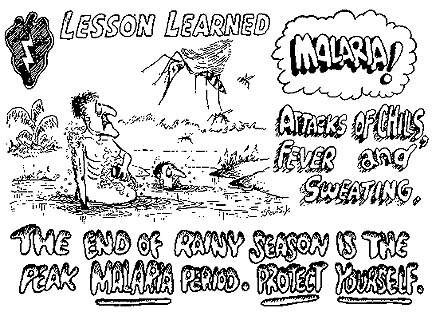 |
Project Transition: A Chance
Every year thousands of army personnel return to civilian life -
all seeking different types of employment. In 1968, a program known as
Project Transition was established by the Department of Defense to provide these
returnees with further education or skill training that could help them obtain
meaningful employment.
Project Transition is designed to assist servicemen who need more
formal education or do not have civilian job skills. The program provides
counseling, academic and vocational instruction and job placement information.
On-the-Job training is also available under Project Transition.
The values of Project Transition are many in that it:
• Affords individuals an opportunity to examine the many
educational and. vocational opportunities available to them.
• Provides a means to adapt a soldier’s in-service training to
the immediate needs of the civilian community.
• Eliminates social and economic adjustment problems for many
Vietnam-era servicemen.
Details on Project Transition are available at major Army education
centers everywhere.
 |
BEFORE AND AFTER - A canteen shows size scale of a 60-pound anti-lank mine found five kilometers north of Fire Support Base Patton II by Alfa Company, 2d Battalion, 14th Infantry. At right, two Golden Dragons look on from a safe distance as the mine is blown in place. The tiny detonator is hard to spot on mines like these. Keep a sharp lookout for anything metallic, no matter how small. (Photo by PFC Ray Byrne) | 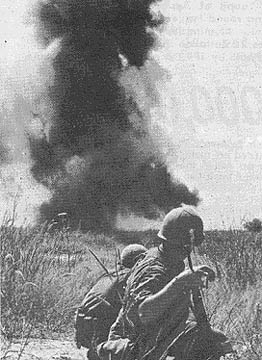 |
Tropic Lightning Tots
The Commanding General Welcomes
The Following Tropic Lightning Tots
To The 25th Infantry Division – As
Reported By The American Red Cross.
Born To:
| November 12 SP4 Charles William Jr., HHC 2/14 Inf, girl PFC Terry L. Borland, HHT 3/4 Cav, girl November 13 PFC Samuel Fulmer, A Btry 1/8 Arty, boy November 15 SP4 Jimmie R. Roland, C Btry 3/13 Arty, girl November 16 1LT Timothy P. Weltin, 595 Eng Bn, boy November 17 SGT Issac C. Goodson, Co E 2/14 Inf, boy |
November 17 SP5 Lavern E. Young, Co D 725 Mn Bn, girl SP4 Patrick J. Healey, Co E 725 Mn Bn, boy November 18 SGT Joseph A. Nepi, Co D, 1/27 Inf, boy SGT John E. Potteriger, Co B 2/27 Inf, boy PFC Andrew H. Rohen, C Btry, 2/77 Arty, boy November 19 SP4 John C. Cary, 25 MP Co, boy November 20 PFC Jerry W. Marshall, B Co 2/14 twin boys |
The TROPIC LIGHTNING NEWS is an authorized publication of the 25th Infantry Division. It is published weekly for all division units in the Republic of Vietnam by the Information Office, 25th Infantry Division, APO San Francisco 96225. Army News Features, Army Photo Features, Armed Forces Press Service and Armed Forces News Bureau material are used. Views and opinions expressed are not necessarily those of the Department of the Army. Printed in Tokyo, Japan, by Pacific Stars and Stripes.
MG Harris W. Hollis . . . . . . . Commanding General
MAJ Warren J. Field . . . . . . Information Officer
1LT John C. Burns . . . . . . . . Officer-in-Charge
SP4 Harold O. Anderson . . Editor
PFC R. D. Silberblatt . . . . . . Assistant Editor
SGT John Genitti . . . . . . . . . Production Supervisor
BATTALION CORRESPONDENTS
| SP4 Dennis Bries SP4 Bill Frame SGT Bill Obelholzer PFC Jim Williams SGT Wally Baker SP4 Frank Ditto PFC Greg Stanmar SP4 Phil Jackson SP4 Pat Morrison SP5 Tony DeBiasio PFC Rich Fitzpatrick SP4 Jeff Hinman SP4 Ken Fairman |
2/22 4/23 4/23 2/12 2/34 2/14 2/14 2/27 3/13 2/12 1/5 2/12 DIVARTY |
PFC Doug
Sainsbury SGT Larry Goodson SP4 Ken Barron SP4 Tony Crawford SP5 Pete Freeman SP4 Craig Sampson SP4 Richard Sears SGT K.C. Cullen SP4 Henry Zucowski SP4 Brad Yaeger PFC Frank Rezzonico SGT Tony Camelio PFC Ray Byrne |
2/77 2/12 1/8 4/9 7/11 2/27 4/9 3/22 2/22 1/27 1/27 3/4 2/14 |
Page 3 TROPIC LIGHTNING NEWS December 1, 1969
Tomahawks Rummage in Rubber Rubble
By SP4 JOHN W. FRAME
TAY NINH - There were lights in the rubber trees and movement had
been spotted by Bravo Company, 4th Battalion (Mechanized), 23d Infantry from its
night laager position. Less than a thousand meters north of the Michelin
rubber factory was a suspected NVA base camp.
“Intelligence reports told us that the Michelin rubber factory in
Phu Khuong District was being used by local enemy and NVA forces as a staging
and resupply area,” said Captain Frederick Drew, commander of Bravo Company.
The once prosperous and functional factory now a rubble-strewn
area, has an intricate system of underground tunnels once used for the passage
of heat from the huge furnaces. These tunnels were being used by the
enemy. Clearing and checking out the tunnel maze was the task at hand.
Armed with flashlights and M-16s, Bravo Company carefully moved through the
area.
“My tunnel rat training came in handy,” commented Private First
Class Ted J. Corum of Tulsa, Okla. “Many of the tunnels and caves were
reinforced with concrete but usually veered off and ended as an unsuspecting
spider hole,” said Private First Class Larry W. Key of LaPuente, Calif.
The area was an excellent area for the enemy to plant his deadly
booby traps, so each doorway, crack and crevice was approached with extreme
caution. Several booby traps of various types were discovered and blown in
place during the operation.
Through combined operations, the Tomahawks have been working
closely with Phu Khuong District local forces and civilians.
“We have gained invaluable information pertaining to enemy
activity, weapons, and ammunition caches,” said Sergeant Robert F. Rembecke of
Morrisville, Pa., the liaison between the Tomahawks and the South Vietnamese
forces in Phu Khuong District. “The Tomahawks are making an all-out
effort to work with the South Vietnamese in extinguishing the enemy threat.”
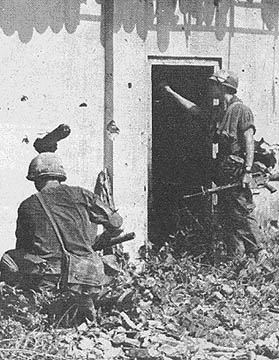 |
TWO TOMAHAWKS of Bravo Company carefully check for booby traps in the rubble-strewn area of the Michelin rubber factory. The building shows the signs of recent fierce fighting in the area. (Photo by SP4 John W. Frame) |
| THUMBS DOWN-Sergeant Eddie DeMary of St. Charles, La., checks out a tunnel during an operation with Bravo Company, 4th Battalion (Mechanized), 23d Infantry Tomahawks in the Michelin Rubber Plantation. (Photo by SP4 John W. Frame) | 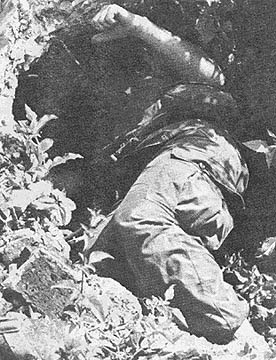 |
‘Mini-Cav’ Brings Maxi-Smoke on Foe
By SGT TONY CAMELIO
CU CHI - Miniskirts revolutionized the art of girl-watching.
In time, perhaps, the mini-Cav will do same for the art of Charlie-finding.
Major Eural E. Adams, Jr., commanding officer of Delta Troop, 3d
Squadron, 4th Cavalry, said, “We noticed in the last few months that the enemy
has been working in small groups, hitting and moving away quickly. We’ve
found that the best way to combat these small enemy forces is by using small
units of our own, and this is where the idea of using the mini-Cav has proven so
successful.”
Staff Sergeant Carl Hutchens of Houston, aero-rifle platoon
sergeant, said, “The platoon was broken down into two smaller units of 15 men
and two Kit Carson scouts apiece. Being broken down into these smaller
units offers the mini-Cav better control of the men and allows them to move in
and out of an area quicker, thus enabling the Cav to go more places in an hour
than if they employed a whole platoon.”
The mini-Cav is working. During a recent month’s period,
the mini-Cav killed 18 enemy, detained 30 suspects, and confiscated 12 enemy
rifles, four pistols, 50 RPG-7 rounds, 100 Chicom grenades, 500 rounds of AK-47
ammunition and medical supplies.
Little Ol’ Lady Is A Dirty Ol’ Man, Dragons Discover
CU CHI - It was Saturday. The little old lady had her
shopping list made up, and she was on her way to the market.
Unfortunately for the little old lady, the list she carried was of
goods requested by nearby North Vietnamese soldiers. Then she ran into the
Reconnaissance Platoon of the 2nd Battalion, 14th Infantry and its Vietnamese
counterpart.
“You should have seen some of the things she had on that list,”
said Specialist 4 James Remmel of Rochester, N.Y., “watches, batteries, cloth
- a lot of things I couldn’t get myself.”
The only thing she managed to get up to the point of her detention
was some bagged rice. She left the market place on a helicopter bound for
Cu Chi base camp and interrogation.
Lifesaving Police Call
CU CHI - A recent operation of the 2d Battalion, 27th Infantry’s
Reconnaissance Platoon turned out to be nothing more than a police call -
policing up Charlie’s booby traps.
As they were sweeping along the banks of the Vam Co Dong River near
the Sugar Mill, members of the mixed Vietnamese-American platoon discovered
three booby trapped bangalore torpedoes embedded in the river bank.
They were rigged to detonate upon contact with river craft used to
insert allied troops in search of cache sites.
The bangalore torpedoes were disarmed and taken back to the
platoon’s camp at the Sugar Mill.
The battlefield police call continued as the platoon sloshed
through mud and swamp to find and destroy seven other booby traps. Four
more were disarmed without injury to any of the platoon members.
| Stars Above! Generals Fly CU CHI - The 25th Aviation Battalion runs perhaps the world’s most exclusive flight school - you must be a brigadier general or higher to attend. The school is run in conjunction with the General Officer’s Rotary Wing Qualifying Course taught at Fort Rucker, Ala. In the past five months two generals have successfully completed the school. The student is required to complete 200 hours of flight time in order to graduate. That 200 hours is divided between flights with the 25th Aviation Battalion and Fort Rucker. The school’s students thus far have been Major General Ellis W. Williamson, former division commander who is now completing his flying time at Fort Rucker, and Brigadier General T. J. Camp, Jr., current assistant division commander who started his training Sept. 7. Instructor for both generals was Chief Warrant Officer Jack C. Bryan. General Camp completed his training Nov. 7 and was awarded the wings of an army aviator.
25’s A Crowd |
|
2 VC Trip on ‘Bush During Night Stroll
By SP4 BRAD YAEGER
TRA CU - A Wolfhound rifleman from the 1st Battalion, 27th
Infantry, on his second ambush patrol, ruined a night’s activities for two
Viet Cong near the Vam Co Dong River.
The action took place with the first platoon of Delta Company while
it was on a night ambush south of Tra Cu.
After being inserted by Navy gunboats the platoon set up four-man
positions along the bank of the river.
The new man, Private First Class Leonard Bustamente of Encino,
Calif., was on guard when he heard strange noises in the night.
“I heard rustling noises in the brush to the left, along a berm
which ran into our position,” he said. “The noises got closer, so I
set off my claymore mine - there wasn’t time to wake up anybody else.”
After the blast the other members of the squad were up fast and the
squad leader, Sergeant Joe Padian of Baltimore, was the next to set off his
claymore.
Then the rest of the claymores were detonated and the men began to
rake the area with fire from M-79s, M-16s and grenades.
A check of the area in the morning revealed two dead enemy soldiers
with their equipment. An interesting find was a reed-filled poncho which
the enemy had used to float across the river with a canoe paddle for propulsion.
Also found were an AK-47 with four loaded magazines, two sacks of rice, a
mosquito net and two hammocks.
Page 4-5 TROPIC LIGHTNING NEWS December 1, 1969
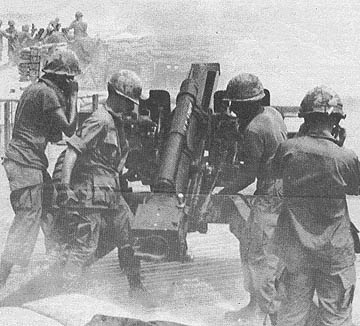 |
No time to waste in a fire mission; a gun crew works out. |
| With another round off in the background, a crew strains and waits. | 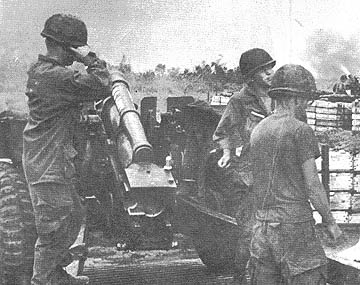 |
In Support of Infantry
7/11 Cannoneers Put Steel on Target
TAY NINH - The artillery is the most readily available support to
which an infantry commander has access. The field artillery is more mobile
and versatile than ever before, and has never been more effectively employed
than on the battlefields of Vietnam.
The 7th Battalion, 11th Field Artillery supports Tropic Lightning
infantrymen of the First Brigade operating all over Tay Ninh Province, from the
northern woods of Thien Ngon to the southern tip of the Angel’s Wing near the
Cambodian border, and as far east as the Boi Loi Woods.
Whether it is “prepping” an area for an eagle flight landing,
firing directly or indirectly for ground troops in contact, pouring out
counter-mortar and rocket fire, or firing point blank in defense of their own
fire support base, guns of the 7/11 Artillery have always come through with
fast, accurate fire.
“On Time, On Target” is the battalion motto and it typifies the
essence of the field artillery-speed and accuracy. The 105mm howitzers of
the 7th Battalion, 11th Field Artillery levelled their tubes in defense of
Frontier City and again later at Fire Support Base Crook, two of the most
lopsided allied victories of the war.
The 7/11 artillery cannoneers know their jobs - putting steel on
the target.
|
Photo Feature |
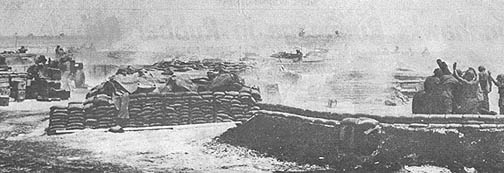 |
| The fire support base is a sea of smoke during a battery
contact fire mission. Clouds of smoke rise as counter-mortar fire hits point blank targets just outside the wire. |
 |
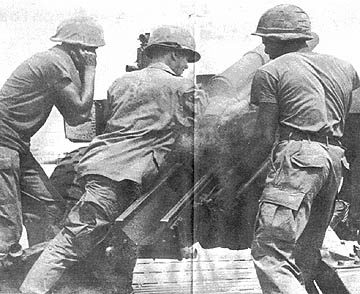 |
Cannoneers of the 7/11 Artillery – On Time, On Target |
| A puff of smoke billows at the rear of the gun during a fire mission. | 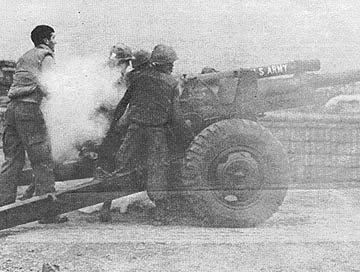 |
Page 6 TROPIC LIGHTNING NEWS December 1, 1969
DEAR SERGEANT CERTAIN: We all know about the most
popular medals, Bronze Stars, Silver Stars, Air Medals, etc., but I’m
interested in learning about some of the more obscure ones to make sure I get
all the civil service points I have coming to me.
SP4 M.T. “Bear”
Chested
DEAR M.T.: With complete disregard for my own sanity, I have investigated
the situation, defying the holocaust of hostile comments rained upon me by the
aggressor awards and decorations section. Here are some of the more
significant awards: The C-Ration Medal with P-38 Device, for devotion to
eating ham and lima beans and the crackers from the B-2 unit or for willingly
giving up a can of peaches and a pound cake; The AFVN Fanship Medal, for
fearlessly exposing yourself to the Polka Hour for three or more consecutive
Sundays; The Friendly Trooper Award, for serving a complete tour without
once cursing the army (this decoration has not been awarded since June 13, 1775
which was the day before the Army was organized); The Hot Air Award, a
special medal for Chinook pilots who knock down six or more men with the blast
from their exhausts or overturn three bunkers at one time with prop wash;
The Base Camp Warrior Medal, for completing a tour without once falling off the
reactionary force truck; The KP Medal with Steel Wool Device, for
maintaining strict discipline while overseeing the edible and inedible garbage
cans; the R&R Realism Medal, for anyone valorous enough to come back
and say he didn’t have a good time on R&R; the Lackluster Service
Cross (LSC), for anyone who doesn’t get any other medals and has lost his
Sharpshooter’s Badge and National Defense Medal.
DEAR COMRADE CERTAIN: First of all, I want to thank you for arranging my
exchange R&R to Hawaii. I had some trouble with MPs not wanting to
accept my NVA ID card, but everything else went smoothly. I’m sorry the
GI who went on our R&R program to Siberia hasn’t returned yet. The
success of the exchange, however, encourages me to suggest another program to
Friendly-ize the war. We have a service club called Hanoi Southwest that
we’d be glad to open to Americans. Our activities include a record
library of speeches by Chairman Mao, books and magazines of Chairman Mao’s
writings, TV-watching with the “Chairman Mao Show,” discussion groups of the
thought of Chairman Mao, Chairman Mao coloring books, and Chairman Mao movies.
We also have something like Doughnut Dollies, only they’re called
“Mao-Lasses,” serving Koolie-ade. The club is open every. morning from
two to four a.m., closed on Chairman Mao’s birthday and during B-52 strikes.
What do you say?
2d Guerilla Nguyen N.
Nguyen
DEAR NGUYEN: Nice to hear from you again. I’m glad you had a good time
in Hawaii, but is it true that you went on a shopping spree and are now the only
man in your unit who wears Keds instead of Ho Chi Minh sandals? Anyway,
about the service club: we’d not only be glad to visit yours, we’ll
contribute to it a Monopoly game, a dozen copies of “Six Crises”, and the
collected recordings of Kate Smith.
 |
SIGN OF THE SEASON - Private First Class Fred Maul and Command Sergeant Major Charles Smith have been busy sorting Christmas gifts that have been rolling in since Maul initiated a project to help the children of Duc Hanh B. (Photo by PFC Doug Sainsbury) |
Santa Wears OD:
Arty Spreads Xmas Cheer
By PFC DOUG SAINSBURY
CU CHI - A Santa Claus dressed in green will visit the children of
Duc Hanh B and other nearby hamlets this Christmas.
He’s not quite as plump as the white-whiskered December
globe-trotter, but Private First Class Fred Maul of Los Angeles, 2d Battalion,
77th Artillery artist, will be lugging a huge sack crammed with clothes, toys,
and candy for the kids.
“He was painting road signs for school zones in Duc Hanh B,”
said Command Sergeant Major Charles L. Smith of Oakland, Calif. “That’s when he got the idea of initiating a Christmas program for the
children.”
“I NOTICED that the kids didn’t have much to play with, but
they took good care of what toys they did have. I thought it would be a
good idea to try to get clothing such as shorts, tennis shoes and T-shirts in
addition to toys,” said Maul.
It was at this point that Maul’s imagination kicked into gear and
the idea snowballed into a full-scale project. He wrote to his wife and
suggested the possibility of people back home sending articles to kids here for
Christmas.
“I also wrote to friends, Mr. and Mrs. Vernon Dallas of Los
Angeles. They presented the idea to local newspapers and the papers ran a
story asking people to donate new or used clothes and toys of all types,” Maul
said.
“THE RESPONSE was great as many people brought things to the
Dallas’ pet shop, and they have been sending them to us. They’ve paid
all shipping costs,” Maul said.
As large packages loaded with toys, clothes and candy arrive at
2/77 Headquarters, Maul sorts them and prepares them for presentation. He
intends to put three or four toys and some candy in individual bags so that more
kids will have presents at Christmas.
“The larger toys will be given to Vietnamese province hospitals
for the kids there,” he said. “Dolls and large trucks will be kept by
the hospitals for the kids who are patients.”
The gifts will be presented to children as close to Christmas Day
as possible.
“IT IS A great idea for a young man to attempt to help these
people in South Vietnam in his personal way. In my three years in Vietnam
I’ve never seen a young enlisted man who has had the initiative to promote a
program of this nature. He has the complete support of myself and
Lieutenant Colonel Lewis Wright, our battalion commander,” said Smith.
“Packages of toys are still coming in and the response of the
people of Los Angeles has been immediate and far better than I anticipated,”
Maul said. “T h e program should help strengthen our pacification
efforts in these same hamlets and villages.”
3d Brigade NITECAPs Put VC Hopes to Bed
By SP4 BOB STEPHENS
LOC THANH - A new kind of pacification project designed to show
Vietnamese villagers that the Viet Cong no longer rule the night was carried out
here by the 2d Battalion, 27th Infantry (Wolfhounds), 25th Infantry Division.
The Night Time Civic Action Program (NITECAP) is a recent
innovation whereby U.S. elements enter a village in late afternoon and stay on
into the night treating the sick and providing the people with entertainment.
At about 4:00 p.m., a small convoy made up of 2d Wolfhound’s S-5
and medical staff along with a Home Entertainment Team (HET) from the 4th Group,
6th Psychological Operations Battalion left nearby Fire Support Jackson and
headed for the village.
A large supply of medicine had been brought in foot lockers
enabling the medics to handle almost any situation that didn’t require open
surgery. The aid station was set up on tables and ailing villagers waited
in line to be treated.
Before long, the medics had their hands full and were kept busy
until 7:30 p.m. when it became too dark to continue.
As the clinic was being disassembled and packed away, the HET
prepared to show films.
The movies featured a variety of subjects that mixed subtle
propaganda with light entertainment. There was singing, magical tricks,
commentaries on life in the U.S.A. and a slapstick comedy about two bumbling
Viet Cong who were reminiscent of Laurel and Hardy.
“We’re not trying to hit these people with really hardline
propaganda,” said HET leader 2LT Charles H. Hochmuth of Washington, D.C.
“Our main purpose is to provide entertainment and the people really appreciate
it.”
“Although this was the first time we’ve tried this kind of
operation”, said Captain William W. Curl III, Columbus, Ga., Wolfhound’s S-5
officer, “it was a great success. We’ll be having more in the
future.”
Page 7 TROPIC LIGHTNING NEWS December 1, 1969
Presenting . . . the New Christy Minstrels
Seven young people playing guitars, banjos, tambourines, you-name-it. A fantastic young singer named Sally Blair was with them. The New Christy Minstrels came to Cu Chi, and for a couple of hours the Lightning Bowl seemed almost like an auditorium back in the world.
|
|
Page 8 TROPIC LIGHTNING NEWS December 1, 1969
A Productive Citizen
Rallier: Man with a Future
By PFC A.C. ECHTHONOKKER
BAO TRAI - A classic example of a hoi chanh is the man who tells of
hearing PSYOPS broadcasts while he was at an enemy refuge inside Cambodia and
made his way across the Plain of Reeds that night to turn himself in.
“When he popped out of the bushes near Tra Cu with his hands up,
there were three fifties mounted on a patrol boat aimed at him,” said Major
Cullen Allen of Wichita Falls, Tex., the 3d Brigade civil affairs officer.
Another classic may be the co-village chiefs who rallied in late
October. “They had been communists since back in the forties,” Allen
said. “When a 67year-old man decides to rally to the government, we
feel as though the program is going pretty well.”
THE PROGRAM is the accelerated PSYOPS project that has been
underway since the 3d Brigade undertook the mission of pacifying Hau Ngia
province. Allen said that more than 1,000 of the enemy have rallied in the
past three months. “That’s more than 300 a month,” he said.
“More than half of the hoi chanhs at Tay Ninh come from Hau Nghia
too,” he said. “They’ve been telling us the waiting lines at our
receiving centers are too long. We’re trying to expand.”
“We’re glad we didn’t have to meet all of those people on the
battlefield,” he added.
Many of the hoi chanhs were laborers - persons who were forced to
work for the Viet Cong. Others were part of the infrastructure.
Still others are draft dodgers or deserters from the ARVN army.
They’re the minority, according to Allen.
“WE TRY TO make the hoi chanhs productive citizens,” Allen
said. “They may become part of the successful Kit Carson scout program
if they choose or they may seek training in a craft.”
Hoi chanhs are free to return to their homes after their training.
Men of draft age are exempt for six months. After that they usually become
productive members of a government military force, according to Allen.
Those who return to their homes are well received by their
communities because the people believe the hoi chanh has demonstrated his faith
in the government by rallying in the first place, he said.
“We consider them good risks after they go home,” Allen said.
“The primary reason is that the communists, by their very nature, can never
again rely upon a person who has forsaken the party.”
Dragon MEDCAPs Fight Unseen Foe
By PFC RAY BYRNE
CU CHI - A Golden Dragon MEDCAP team is proving that the surgical
syringe as well as the pen is mightier than the sword.
Captain Howard Hanna Jr., surgeon for the 2d Battalion, 14th
Infantry, and his band of medics and interpreters almost daily go into the
hamlets of the unit’s area of operations.
“Because of the nature of this war,” Hanna said, “many of the
residents of these hamlets are related to the enemy still out in the rice
paddies. We could just let them be. Let Hanoi worry about sending
them their own doctors; but we can’t. We’re out to win these people
over and to keep them on our side.”
Each day a portion of the nearly 10,200 residents of Trung Lap and
the New Life village come in droves to the impromptu aid station. Beneath
the shade of large rubber trees, the MEDCAP team administers medicine, vitamins,
cold pills and cough syrup. They also clean and dress the various scraped
knees or stubbed toes of the children.
“If we are unable to treat a patient on the spot, an appointment
can be made in Cu Chi or Saigon,” Hanna said. “Of course, we supply
the transportation.”
Precautions are also taken to insure that the medicine does not
fall into enemy hands.
“However, if it ever did,” interpreter Nguyen Long said, “it
would most likely work to our advantage. The medicine being American and
given to the people of South Vietnam might only make the VC decide to chieu
hoi.”
Day Training Aids Hounds
CU CHI - Daytime weapons training has become part of the routine
for Wolfhounds in Bravo company, 1st Battalion, 27th Infantry.
During the hours the men spend inside the patrol bases they are
learning and practicing the operation of M-60 machineguns, grenade launchers,
anti-tank weapons and even mortars.
“The training greatly increases the combat effectiveness of the
unit,” First Lieutenant Richard D’Andrea of Chicopee, Mass., company
executive officer, said. “Some of the men had fired the LAW or the M-79
only a few times before coming to Vietnam.”
“We’re trying to cross-train all of the men in all of the
weapons. It’s building their skill and confidence,” he said.
| WALKING A TIGHTROPE? Not quite, but this machine gunner with Charlie Company, 2d Battalion, 12th Infantry does a nice balancing act while walking over unfamiliar terrain on a search operation south of Fire Support Base Pershing. (Photo by PFC Jim Williams) |  |
Recon Rifles 11 Rifles
CU CHI - Elements of the 2d Battalion, 27th Infantry reconnaisance
platoon along with their Vietnamese counterparts were recently led to an enemy
cache which included 11 rifles.
Through civil grievance channels, a Vietnamese villager reported
knowing where the Viet Cong had buried some weapons and offered to lead allied
soldiers to the site. A combined operation was subsequently planned for
the following day.
The actual locating of the 11 assault rifles and three boxes of
ammunitions found with the arms cache was not the easy job the guide had
suggested. The weapons were 500 meters from where they were originally
thought to be.
“As we started to dig down on that cache,” said First
Lieutenant Robert Vadnais of Arlington, Va., “we received sniper fire.
I’m sure it was to draw us out of the area.”
An element was sent out to locate the snipers, but the enemy fled
before they could be pinpointed and followed.
The captured weapons were given to the Vietnamese units as is the
policy of the Wolfhound’s recon platoon.
| ALWAYS ON THE ALERT - Troopers from the 2d Battalion, 14th Infantry keep a watchful eye out for anything that moves as they cautiously make their way through tall grass northwest of Cu Chi. (Photo by PFC Ray Byrne) | 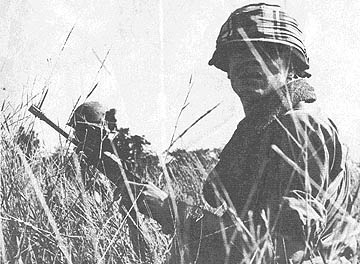 |
The Five-Dollar Conspiracy?
Thanks to
Ron Leonard, 25th Aviation Bn., for locating and mailing this issue,
Kirk Ramsey, 2nd Bn., 14th Inf. for creating this page.
This page last modified 8-12-2004
©2004 25th Infantry Division Association. All rights reserved.